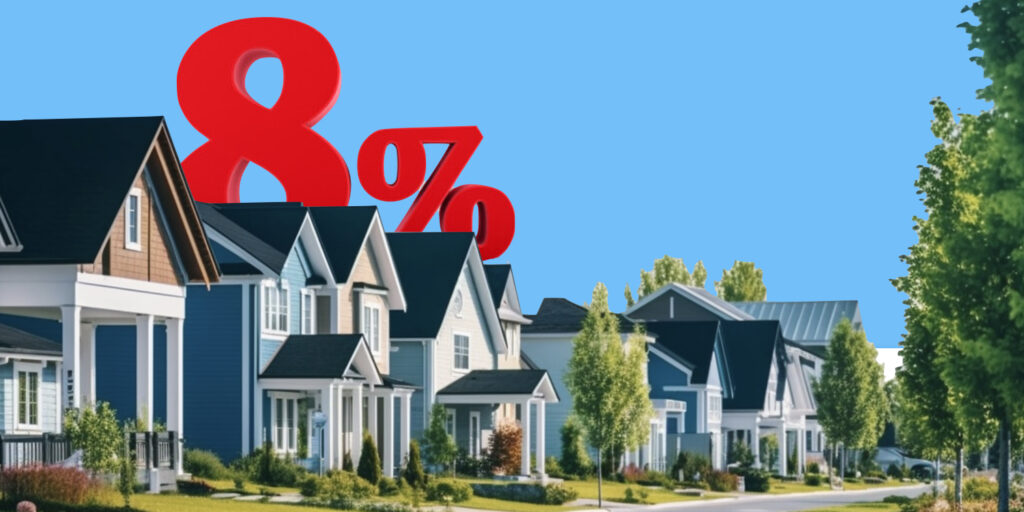In today’s financial landscape, we find both the average HECM expected rate and the traditional 30-year mortgage hovering around eight percent. In this episode, we’ll delve into why this convergence offers a distinct advantage to reverse mortgage lenders and originators.
According to Money-com, predicting whether these rates will rise above or stay at 8% is uncertain due to numerous influencing factors. Chen Zhao, economics research lead at Redfin, suggests that the possibility of rates reaching or surpassing 8% is well within the realm of possibility — potentially unsettling news for prospective homebuyers and sellers. Well, that time has already come.
In the past month, individuals with average credit and smaller down payments have already secured mortgages at rates as high as eight or nine percent.
You might wonder how record-high mortgage rates could possibly benefit reverse mortgage lenders. Firstly, over the past decade…
[read more]
the HECM’s initial expected rate and ongoing rates have surpassed those of traditional mortgage loans. This discrepancy has fostered the belief that reverse mortgages were inherently more costly. However, due to the recent surge in 30-year fixed-rate mortgages, the HECM now stands on a nearly level playing field.
Secondly, prospective homebuyers tend to focus on interest rates. With the average 30-year mortgage now at eight percent, older homebuyers might be more open to using a HECM for Purchase to transition into a new home. While the H4P demands a significantly higher down payment, it offers several distinct advantages, albeit with the caveat of upfront and ongoing mortgage insurance premiums. These advantages include the ability to avoid tying up a substantial portion of liquid assets in the new property and the flexibility to choose when to make or skip payments based on unforeseen circumstances or immediate financial needs. This helps prevent the homebuyer from falling behind on essential mortgage payments, safeguarding their credit score and future borrowing capacity for auto loans, credit cards, or other financed purchases.
Despite home values still being 25-40% higher than pre-pandemic levels, the interest in cash-out refinances has notably contracted. Few are inclined to refinance their homes for a cash-out option and double their interest rates and monthly payments to tap into their equity. This makes the HECM’s line of credit or a proprietary second reverse mortgage more appealing to budget-conscious borrowers, as it doesn’t inflate their monthly debt obligations.
Given the Federal Reserve’s vigilant stance on inflation and potential future rate hikes, it’s probable that traditional mortgage rates will remain elevated well into the next year. While these higher rates certainly shrink the available loan proceeds for reverse mortgage borrowers, the elimination of the interest rate gap between traditional and reverse mortgages could alleviate resistance to both HECM and proprietary loans.
In the grand scheme of things, as one NRMLA attendee aptly put it, “It’s just a loan.” The distinction lies in one not requiring monthly payments and potentially securing a credit line impervious to freezing or reduction.
What are your thoughts? Despite the lower principal limit factors, what advantages do you see with traditional and reverse mortgage interest rates being nearly identical? Please share your comments below.
[/read]







7 Comments
The high interest rate environment is providing for much faster LOC growth!
Those with a mortgage balance can make voluntary payments which reduces the amount of interest accruing which also increases the available LOC which grows at the 8%. A double-barrelled benefit!
Those with free and clear houses can take out a reverse and only accrue interest on the fees while the remaining PL is in the available LOC which will grow at 8% compounded monthly.
Excellent points, Jeff!
[…] Why 8% 30-year fixed rates may benefit reverse… […]
Shannon – my last several client proposals with a need for cash have included an analysis of a cash out refi, HELOC and HECM. Given that the rates on a HELOC are higher than a HECM and the cash out and HECM are on Par – the HECM is winning more often!
John- that’s fantastic news! A story that deserves to be shouted from the rooftops. Thank you. It was great to see you in Nashville!
John,
Does your analysis include ongoing MIP?
Yet the principal limit on an adjustable rate HECM is not determined by the 10 year CMT alone. The margin is also a factor in the determination of both the expected rate on an adjustable rate HECM and its adjustable note interest rate. Further, not only does the UPB on a HECM grow monthly by the sum of the note interest rate plus the ongoing MIP rate divided by 12 but so does the HECM LOC. Far too many times recently I have heard HECM originators tell listeners that the HECM LOC grows by the interest rate but that is not true; it grows as previously stated, i.e., it grows monthly by the note interest rate charged that month plus the ongoing MIP rate divided by 12.
For example, if the ongoing MIP rate is 1.25% (on HECMs with CNAs [case numbers assigned] after 9/30/2010 but before 10/2/2017) and the note interest rate for that month is 8%, the compounding rate on the HECM LOC that month would be 0.77083%. If the HECM LOC was $100,000 as of the end of the prior month, the increase in the LOC (assuming no pay downs or draws) should be $770,83.